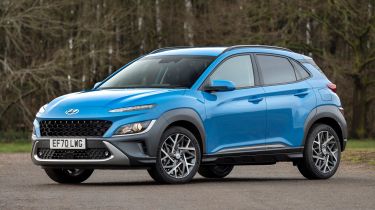Hyundai Kona SUV - MPG, running costs & CO2 (2017-2023)
The Hyundai Kona offers reasonable economy but its not class-leading
The facelifted Kona is only available with one petrol engine. Hybrid and electric versions of the Kona are also popular, and the Hybrid is arguably the best all-rounder in the Kona range. The fully-electric Kona will be the most desirable version in the range for many customers but it's more expensive to buy and lease. Buyers keen on performance rather than low running costs are catered for by the hot Kona N.
The 1.0-litre mild-hybrid petrol engine is the most affordable and helps the Kona keep pace with rivals for efficiency. A diesel version is no longer offered.
Hyundai Kona MPG & CO2
The 118bhp three-cylinder 1.0-litre petrol engine returns the best figures in entry-level trims, because these models have smaller, 17-inch alloy wheels compared to the other cars in the range. With the car in this configuration, the engine is capable of up to 47.1mpg with CO2 emissions of 135g/km, making it the least expensive in the regular Kona range for company-car drivers.
Move up to any of the higher trim levels and you get at least 18-inch alloys, which means figures for the 1.0-litre engine drop to 46.3mpg and 138g/km of CO2. For the facelift, the 1.0-litre was fitted with some impressive technology, including its 48-volt mild-hybrid system. This recovers energy as the car slows down, then stores it to give the car a small boost under acceleration.
More reviews
A clever Intelligent Manual Transmission (IMT) - with no physical connection between the clutch pedal and gearbox – can also let the engine turn off and on seamlessly while cruising to save fuel. Previously this was only possible in cars with an automatic gearbox.
In the pre-facelifted Kona, the 175bhp 1.6-litre petrol engine was only available in the range-topping Premium GT model with an automatic gearbox, and it's now been discontinued entirely. That model came with 18-inch alloy wheels and four-wheel drive, which, combined with the extra power, dropped fuel economy down to 34mpg while placing it at the top of the BiK ratings for company-car drivers. The high-performance 276bhp Kona N achieves a similar figure.
Thanks to its mild-hybrid tech, even the standard Kona qualifies for a slightly discounted yearly VED (tax) bill. The Kona N is charged the full amount (£10 more per year), while the Kona Electric is exempt from road tax due to its zero-emissions status.
Insurance group
Insurance groups for the 1.0-litre petrol engine have been released, and the SE Connect sits in group 10 out of 50. This means the Kona is likely to be cheaper to insure than the Renault Captur, which spans insurance groups 16 to 19.
Warranty
Hyundai offers one of the best warranties available on new cars. The Kona is covered for unlimited miles over five years, which, depending on how much driving you do, isn't far behind Kia’s seven-year/100,000-mile warranty.
Servicing
Hyundai offers fixed-price servicing packages, meaning budgeting for maintenance will be easy. Three years’ worth of services for a petrol Kona is likely to come in at around £500.













